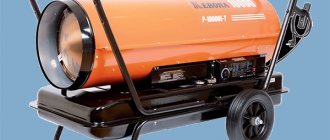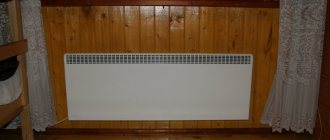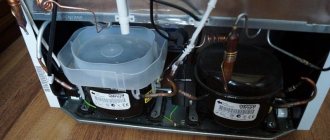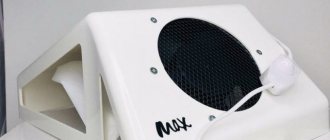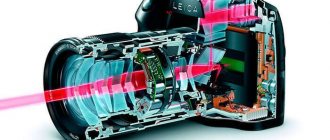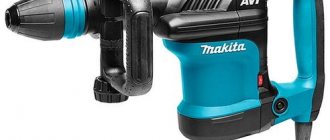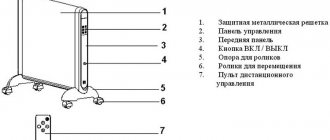Working principle of quartz slab
A quartz stove is an electric heater in the form of an embossed panel, sometimes with decorative elements. It works due to a heating coil, which heats up to a maximum temperature (sometimes it reaches 100 degrees!).
The heater, in turn, emits heat. Essentially, a quartz stove heats a room equally in two ways: infrared and convection. Infrared heating works like this: the heat that the device emits is absorbed by objects, and convection works so that the air moves from bottom to top, so it will be warmer at the top than near the floor.
Negative points when using
Despite the significant advantages of IR heaters, one cannot fail to note their disadvantages:
- The peculiarity of infrared radiation is that its rays shine in a straight line. Therefore, only those things and objects that are within their reach are heated. Because of this, a contrast arises between the zones where heat has entered and where it has not. For example, if you are sitting at a desk and the heater is placed at chest level, it will not warm your legs.
- It is required to monitor the equipment extremely carefully if there are small children in the house, or completely abandon it in favor of other models. Some parts of the unit heat up to very high temperatures, and burns cannot be avoided if you are careless.
- The device is more suitable for small spaces.
- Fragility. If the vacuum quartz flask in which the heating element is located is damaged, the probability of repairing it is very small, so if such a situation arises, it will be easier to buy a new heater.
- The unaesthetic appearance scares off some buyers, although this is quite a good option for heating a summer house.
Operating principle of an infrared heater
An infrared heater is a device that emits infrared waves, which are easily transmitted by air and absorbed by surfaces in the form of heat. Heat loss is minimal.
Infrared waves are divided into two types: long- and short-wave:
- Long-wavelengths have a beneficial effect on humans because they are identical to the rays of the Sun. They are emitted by devices that have a maximum heating temperature of up to 200 degrees.
- Short-wavelengths have a detrimental effect on human health and are dangerous. They are used in infrared heaters with heating temperatures of 800 degrees.
You can read more about the dangers of infrared heaters here: (link here).
Infrared heaters
An infrared heater, also called a reflector, is fundamentally different from a quartz device.
Structure
IR heaters are quartz flasks with a heating element (tungsten, nichrome wire or carbon strips) enclosed in a metal or plastic housing. The front side of the device is open to IR rays. On the reverse side, behind the tubes, a reflector is placed that redirects the radiation towards the room.
With successful focusing, the scattering angle of reflected waves is minimal, which increases the efficiency of the device. Brackets are screwed or soldered on the back wall, allowing you to hang the device on a wall or ceiling anywhere. The schematic diagram of the device can be seen below.
Principle of operation
Infrared heaters use the ability of quartz (SiO2 - silicon dioxide) to transmit electromagnetic waves in the IR radiation range. To do this, a heating element is placed inside the quartz tube, capable of emitting red-hot infrared waves of different lengths (the wavelength depends on the temperature of the spiral - the higher, the longer).
IR rays, meeting an obstacle (floor, furniture, walls, other objects, as well as a person) transfer their energy to it. The surface heats up, becoming in turn a source of heat for the surrounding air. As you can see, unlike central heating radiators and oil radiators, it is not the atmosphere of the room that is initially heated, but the hard surface.
The device works like this:
- after switching on, the spiral becomes red-hot and begins to emit IR rays;
- the surface of objects within the reach of IR radiation heats up;
- the surrounding air is heated from heated walls, floors, furniture and various objects;
- When the set temperature is reached in the room, the device automatically turns off;
- As the temperature drops, the electrical appliance turns on.
The operating principle of a quartz IR heater.
Specifications
The basic performance characteristics of the main models of IR heaters are as follows:
- operating power - 0.3-0.8 kW;
- maximum power - 3.0 kW;
- weight - 0.7-2.0 kg;
- average efficiency of the device is 87-95%;
- case temperature - no more than +70oC;
- cooling period - no.
Let's summarize the first results: the difference between a quartz heater and an infrared heater is in the structure of the device and the method of heating the room.
Pros and cons of a quartz heater
Before you buy a product, you should familiarize yourself with its capabilities, advantages and disadvantages.
Let's start with the positives. These include:
- Silence.
- Relatively low cost.
- The device does not require the services of a specialist. Often the device comes with a special stand or holders on the wall; this is necessary for comfortable use of the device, and assembling the structure is not difficult, and the heater is ready for use immediately after connecting to the network.
- Does not dry out the air. This is an important factor for people with lung diseases or allergies.
- Economical use. The device works more economically than others in a small area.
Here are the main disadvantages of quartz heaters:
- Fragility. Unfortunately, such heaters are very thin (about 25 mm in thickness), so they can break from the slightest physical impact, not to mention the frequent cases when the device already had cracks when unpacking or was completely broken.
- Specific design.
- Heat. As we already said, the device heats up to temperatures over 100 degrees, which makes it dangerous if there are children or animals in the house.
- Inability to select a comfortable temperature range. Quartz heaters often do not have a thermostat, and if you want the device to heat up to a temperature that suits you, you need to purchase a thermostat and additional services from a specialist.
- Low power. Such devices cannot warm the room completely to the desired temperature, and are definitely not suitable as the main heating method. For a room measuring 18 square meters you will need at least 3 heaters!
Advantages and disadvantages
The compared devices have common pros and cons (discussed in detail here). However, the different structures and operating principles revealed the individual strengths and weaknesses of the devices. This makes it possible, by comparing their advantages and disadvantages, to draw preliminary conclusions: which is better - a quartz or infrared heater.
Quartz heater
The quartz panel has many positive aspects:
- high efficiency - device efficiency is 75-95%;
- rapid heating of the panel - about 20 minutes, after which there is an intensive heating process;
- simple design - there is simply nothing to break;
- simple and quick installation on the floor or wall;
- large thermal capacity, allowing you to maintain a comfortable temperature in the room for a long time after switching off;
- high level of tightness, allowing the device to be used in rooms with high humidity;
- long service life - from 20 to 30 years;
- silent operation (when ceramics are added to the panel, crackling noise is sometimes heard when heating and cooling);
- Voltage fluctuations or short-term power outages do not affect the quality of heating - the panel that has accumulated heat saves the day;
- good design that allows the device to fit into the interior without problems;
- it is possible to connect various types of automation in the form of climate control or thermostat, which will significantly increase the efficiency of the quartz stove;
- ability to work from a smart socket - turned on and off by smartphone.
disadvantages :
- quite high price;
- the weight of the panel makes it difficult to transport and hang on the wall - not every panel can withstand such a load;
- The package does not include a thermostat (only a dozen out of several hundred models have it);
- increased electricity consumption, which does not coincide with the passport data (there, as a rule, power and electricity consumption are equalized, which does not correspond to real consumption due to natural losses);
- like all heaters, it dries the air, although manufacturers claim the opposite;
- fragility of the panel;
- If the heating element fails, the device cannot be repaired;
- high temperature of the surface of the case - you can get burned;
- budget options have an unattractive appearance and a short service life.
Infrared heater
advantages of quartz reflectors :
- affordable prices;
- rapid heating of rooms;
- high efficiency - 87-95% (the ceiling space is not heated);
- there are no convection currents that raise dust into the air;
- almost uniform heating of the room along the height. At the same time, the temperature in the floor area is always higher, which ideally fits the proverb “keep your head cold and your feet warm”;
- easy installation;
- light weight, allowing you to easily move the device from room to room or transport it to the dacha and back;
- long service life;
- maintainability - a burnt or damaged tube can be replaced;
- no maintenance required;
- You cannot get burned on the reflector body;
- compact dimensions allowing you to place the device on a windowsill;
- has the effect of a heat gun - allows you to quickly and evenly dry walls, clothes, a painted car, etc.;
- interesting design - can always be matched to a decorated interior;
- safe operation, including automatic shutdown when tipped over, a grille on the front side (prevents burns), no harmful fumes if the flask is damaged.
some disadvantages . What would it be like without them:
- long-wave radiation is harmful to humans. Therefore, the heating of the spiral should not exceed +300oC (maximum possible temperatures – +1200oC);
- prolonged exposure to direct rays on the human body causes unpleasant sensations. Therefore, the bed should not be in the direct radiation area;
Nice picture, but it shouldn't be like that.
- There is a thermostat built in, but this is pointless, because... greatly reduces the efficiency of the device - shutdowns do not exceed 10 minutes, and heating the coil requires additional electricity;
- rapid cooling of the room when the device is turned off;
- Red light at night has a negative impact on a person’s mental state—lethargy and apathy appear in the morning. A night light will help you avoid problems, but this will add additional energy costs.
Advantages and disadvantages of an infrared heater
The advantageous features of an infrared heater are:
- Radiation. As we have already said, long-wave rays are perceived by humans and any living creatures as warmth, and create an atmosphere of comfort. In addition, the infrared heater can be used in a greenhouse.
- It also does not dry out the air.
- Heat radiation scheme that minimizes heat loss.
- Quick and easy to install.
- The system is immune to cold, and can be kept in the cold (for example, on a balcony, country house or in a country house), and then immediately begin working.
And here are the main disadvantages:
- Harmful to health. It is impossible to stay “warm” all the time from an infrared heater, as this causes dilation of the veins. You can read more about the dangers of infrared radiation here: (link here).
- Not suitable as main heating. And not only because of harm to health, but also because of economic disadvantage.
- No convection.
- Fast cooling. The device cools down immediately when disconnected from the network.
- High temperature of individual parts, which can lead to burns.
- Risk of fire.
Advantages and disadvantages of infrared heaters
Unlike convectors, these devices heat objects in the room, as well as walls and floors, without heating the air at all. Infrared radiation is similar to the sun's rays - it also gives a feeling of warmth, but is not visible to the human eye.
Important! Unlike convectors, infrared heating devices can immediately give a feeling of warmth after it starts working, and it can not be felt throughout the entire room, but only in the place where the device is located.
The design of the device does not contain any complex parts: a steel body coated with durable paint has an aluminum reflector on which a heating element (halogen, carbon, ceramic or tubular) is located.
The device also contains a thermostat, with which you can regulate the temperature and a sensor that turns off the device when the specified temperature is reached. If the heater has a floor-mounted design, it is additionally equipped with a tip-over sensor.
Pros:
- All surfaces that are exposed to infrared radiation begin to warm up and give off heat, heating the air;
- Uniform heating over the entire area;
- Silent operation and high environmental friendliness;
- Long service life and high reliability.
Minuses:
- When using the device for a long time, a person may experience discomfort;
- Quite a lot of power consumption;
- When home furnishings heat up, they wear out faster.
Manufacturers and prices
Of course, if you buy, you want to buy a durable and high-quality device. Here is a list of the most popular brands that meet these criteria:
- TepplEco. The company provides a 5-year warranty on purchased devices, and you can also buy additional accessories: protective film, thermostat and much more.
- TeploPlit. The products of this company, instead of 6-8, can heat 16-18 cubic meters, which is almost 3 times the efficiency of use.
- Centek. The peculiarity of this company’s product is that you can use both 50 and 100% power modes, which allows you to safely leave the device turned on in the countryside, and then you will be greeted with warmth and comfort.
In addition to the above advantages, these companies producing quartz heaters have a large number of positive reviews on the forums.
Recommendations for selection and operation
If you choose between quartz and infrared heaters, you should definitely choose the first one - although it has a number of disadvantages, such as a small heating area, this device is still cheaper and safe for health. But in some situations, an infrared heater will be better, for example, in the bathroom or in the hallway. If you want to use this device in your room, you will have to turn it away from you, which in principle does not affect the temperature of the room, because the heat is absorbed by the walls and radiated towards you.
Watch the video about which electric heater to choose
Results
The choice should be made depending on your home and preferences. If the room is large, an infrared device will handle heating better; if it is small, a quartz device will do the job. If you are in doubt, you can read the article about electric radiators - they will get the job done, are safe and easy to use.
If you liked the article, recommend us to your friends and save it for yourself. Subscribe to our blog! If you have any questions, ask us in the comments, we will definitely answer! See you again!
Sincerely, experts of the StroyDomEconom.RU portal!

